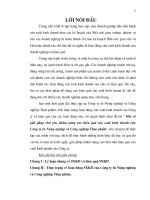Management of Egg bound and oviductal prolapse in duck - Trường Đại học Công nghiệp Thực phẩm Tp. Hồ Chí Minh
Bạn đang xem bản rút gọn của tài liệu. Xem và tải ngay bản đầy đủ của tài liệu tại đây (336.13 KB, 3 trang )
<span class='text_page_counter'>(1)</span><div class='page_container' data-page=1>
<i><b>Int.J.Curr.Microbiol.App.Sci (2017) 6(11): 3972-3974 </b></i>
3972
<b>Case Study </b>
<b>Management of Egg Bound and Oviductal Prolapse in Duck </b>
<b>Laishram Kipjen Singh1*, W. Pipelu2, G.K. Mishra1, Nitish Kharayat1, </b>
<b>M.K. Patra1, S.K. Singh1 and H. Kumar1</b>
1
Animal Reproduction Division, 2Division of Veterinary Surgery, ICAR-Indian Veterinary
Research Institute, Izatnagar- 243122, U.P., India
<i>*Corresponding author </i>
<i><b> </b></i> <i><b> </b></i><b>A B S T R A C T </b>
<i><b> </b></i>
<b>Introduction </b>
Egg bound is a serious disorder condition that
mostly affects young layers in which the egg
is lodged in cloaca but not laid (Crespo <i>et al, </i>
2003). Obstruction of oviduct or uterus by an
egg is a common problem seen mainly in
young female birds at the initial stage of
laying period (Joy and Devia, 2014).
It occurs secondary to any condition that
causes chronic, excessive straining such as
normal physiologic hyperplasia egg laying.
Female ducks which lay abnormally large or
abnormal shape eggs are at higher risk for
developing this condition. The present paper
describes a case of egg bound and its
management aspect.
<b>Materials and Methods </b>
A two year old female duck was presented to
the Referral Veterinary Polyclinic, VGO,
IVRI, Izatnagar, U.P. with history of Egg
bound and oviduct prolapse for past 6 hrs (i.e.
6 o’clock in the early morning) (Fig. 1). The
bird had started laying egg for the past 4 days.
The bird was anorectic and depressed. On
close examination, necrosed area of the lower
part of the oviduct protrudes from the vent
and retained egg inside the prolapsed mass
was observed (Fig. 2).
<b>Results and Discussion </b>
The prolapsed mass was washed with 0.1%
Potassium permanganate solution to prevent
<i>International Journal of Current Microbiology and Applied Sciences </i>
<i><b>ISSN: 2319-7706</b></i><b> Volume 6 Number 11 (2017) pp. 3972-3974 </b>
Journal homepage:
A two year old female duck was presented to the Referral Veterinary
Polyclinic, VGO, IVRI, Izatnagar, U.P. with history of Egg bound and
oviduct prolapse for past 6 hrs (i.e. 6 o’clock in the early morning). Close
examination revealed necrosed area of the lower part of oviduct protruded
from the vent and retained egg inside the prolapsed mass. Prolapsed mass
was washed with 0.1% potassium permanganate solution. Lignocaine 2%
gel was applied over the prolapsed part. The retained egg was gently
removed through the cloacal orifice. Ice cold pack was applied over the
prolapsed area along with purse string suture pattern around the
circumference of the vent, allowing the egg to fit through.
<b>K e y w o r d s </b>
Duck, Egg bound,
Cloaca, Vent,
Potassium
permanganate,
Lignocaine
<i><b>Accepted: </b></i>
26 October 2017
<i><b>Available Online:</b></i>
</div>
<span class='text_page_counter'>(2)</span><div class='page_container' data-page=2>
<i><b>Int.J.Curr.Microbiol.App.Sci (2017) 6(11): 3972-3974 </b></i>
3973
against desiccation and foreign particles
contamination. After washing the prolapsed
part further contamination was prevented by
avoiding the bird to lay down on the ground
and by keeping on clean drapes. Lignocaine
2% gel was applied over the prolapsed part to
avoid straining and to produce anaesthetizing
effect, followed by lubricating the area with
mineral oil in order to keep moist and give
best result. The retained egg inside the
prolapsed tissue was gently removed through
cloacal opening without breaking inside,
otherwise it might cause allergic reaction and
contamination. Ice cold pack was applied over
the prolapsed area to help shrink the swollen
tissue. After about 10 minutes the reduced
swollen mass was pushed back inside the
vent.
<b>Fig.1</b> Prolpase of uterus <b>Fig.2</b> Necrosed part of uterus and egg bound
</div>
<span class='text_page_counter'>(3)</span><div class='page_container' data-page=3>
<i><b>Int.J.Curr.Microbiol.App.Sci (2017) 6(11): 3972-3974 </b></i>
3974
Purse string suture pattern was applied around
the circumference of the vent using black
braided silk, allowing the egg to fit through
(Fig.3). The owner was advised to remove the
suture after few hours. Postoperatively
antibiotic Enrofloxacin was given @10 mg/kg
body weight for 5 days along with oral
calcium supplement. Oviduct prolapse is a
condition in which lower part of laying birds’
oviduct turns inside out and protrudes through
the vent. Suspected cases of egg bound
include lack of calcium or other nutritional
issues, overweight birds, unusually large
or oddly shaped egg, oviduct infection,
premature egg laying, lack of nesting
boxes/safe place to lay the egg etc. Some
researchers (Joyner, 1994 and Harrison, 1986)
also reported egg bound caused by oviductal
muscle malfunction in Calcium, Selenium,
Vitamin E deficiencies, nutritional
deficiencies, obesity and stress. Crespo <i>et </i>
<i>al.</i>(2003) also recorded that young birds
laying extra large eggs were prone to egg
bound which happened in the present case.
Egg binding without torsion or displacement
of oviduct was described by Hasholt (1966).
Samour (2008) opined that caesarian as an
ideal treatment if both egg and hen were
conservative and not responding to medical
treatment. It is therefore advised to provide
adequate nutritional supplement and hygienic
management of young layers to prevent such
condition.
<b>References </b>
Crespo, R and Shivprasad H.L. 2003.
Developmental, metabolic and other
noninfectious disorders. In: Saif YM,
ed. Diseases of poultry, Iowa State
press, Blackwell publishers p. 1231.
Harrison G.J. 1986. Reproductive medicine.
In: Harrison GJ, Harrison LR. Clinical
avian medicine and surgery.
Philadelphia: WB Saunders, p. 620-623.
Hasholt J.1966. Diseases of reproductive
organs of pet birds. J. Sm. Anim. Prac<i>. </i>
313-320.
Joy.B. and T. R. Divya. T.R. 2014. Egg
bound and vent prolapse in chicken - a
review of two cases.J. Vet. Med.12:
91-92.
Joyner K.L.1994. Theriogenology. In: Ritchie
BW, Harrison GJ, Harrison LR. Avian
Medicine, Principles and application.
Lake worth Fl: Wingers publishing p.
758-773.
Samour J.2008. Avian anesthesia and
analgesia, egg binding/ dystocia. Avian
medicine, 2nd edn, Mosby Elsevier,
Elseviers Ltd, p. 525.
<b>How to cite this article: </b>
</div>
<!--links-->






